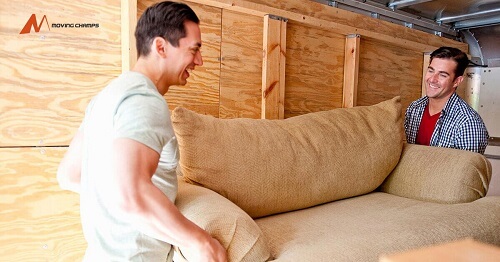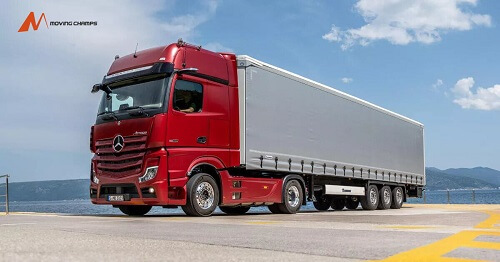5 Eco-Friendly Ways To Transport Goods
It’s not easy being green, stated Kermit the Frog. Instead of driving to work, you ride the bus. Your plastic bottles and drink cans are dutifully recycled. You even got your dog a jumper made from recovered cotton.
But what about that brand-new PC you ordered over the internet?
The parts are manufactured in Indonesia and then delivered to Japan for assembly. The computer then travels across the Pacific on a cargo ship to a warehouse in California. And when you move your belongings while shifting to another state or country. Across the country, delivery vehicles transfer crates of computers to distribution hubs. When you click “purchase,” FedEx loads the product onto a considerable rig, subsequently delivered to your front door by a delivery truck.
Is it practical? Yes.
Green? No, not at all.
Running On Oil Rivers And Emission Clouds
The unpleasant reality is that oil rivers fuel the global economy. The logistical miracle that grows raw materials in Africa, manufactures components in Asia, and assembles products in Europe relies on transportation. Over 90% of cross-border freight transit is handled by maritime ships. According to the International Chamber of Shipping, giant container ships transport 7.7 billion tonnes of cargo each year.
On the other hand, those container ships consume thousands of gallons of bunker fuel, a low-grade fuel with 2,000 times the sulphur level of conventional diesel. According to the Environmental Protection Agency, the transportation sector is the second-largest generator of carbon dioxide emissions, accounting for 33 percent of total greenhouse gas production.
Passenger vehicles contribute a significant share of these pollutants, but heavy-duty freight trucks, which account for only 1% of all vehicles on the road, contribute 20% of total greenhouse gas emissions.
The good news is that the cargo shipping sector is attempting to become more environmentally conscious. We can help by supporting companies trying to reduce their carbon impact—the following list is the five most environmentally friendly ways to move products or your valuables while shifting home or office.

1. Barges On The Water
Large freshwater lakes and vast, quiet rivers provide some of the world’s most energy-efficient shipping routes. Maritime transportation is the most fuel-efficient mode of freight transit in general, with inland barges being the cleanest. While using a quarter of the fuel and releasing significantly less greenhouse gas, a single diesel-powered towboat can push 15 fully laden barges carrying 225 rail cars or 870 truckloads.
Inland barges are unrivaled in terms of fuel efficiency. On a single gallon of fuel, an inland barge can transport a ton of freight 514 miles (827 kilometers). Rail, which can go 202 miles (325 kilometers) on a single gallon, is the closest competition and is less than half as efficient as an inland barge.
So it would be better if you choose this transportation mode while moving your furniture or precious belongings to another country. You can hire Interstate Removalists in Australia to move your furniture.
Inland Barges Vs. Conventional Trucks In The Green Test
According to the National Waterways Council, rail travel produces 39 percent more carbon dioxide per ton-mile (emissions generated when moving a tonne of cargo a single mile) than inland barges, and conventional trucks emit 371 percent more carbon dioxide per ton-mile.
Barges are the least likely vessels to create a toxic spill due to their sluggish pace and robust design. According to a five-year assessment of barge traffic on the upper Mississippi River, commercial navigation was responsible for only half of one percent of spills. Inland barges transported 4.9 billion gallons (18.5 billion liters) of liquid freight during the same time period.
2. Trains That Transport Goods
Trains are the most fuel-efficient mode of land freight transportation. Depending on the cargo, trains are two to four times more efficient than vehicles at transporting freight, and a single freight train may carry the equivalent of 280 truckloads. CSX says that one ton of cargo can be transported 500 miles (805 kilometers) on a single gallon of gasoline.
Since 1980, modern trains have enhanced their energy efficiency by 106 percent. Recent technological improvements in locomotive design and computerized train control will increase fuel efficiency by another 25% or more in the next decade.
Freight rail emits 2.1 percent of the total greenhouse gas emissions produced by the overall transportation sector in the United States. According to the Environmental Protection Agency, passenger vehicles are the most polluters, accounting for 65.8%, although trucks account for 20.4%.
According to the Association of American Railroads, moving 10% of truck goods to railways would reduce greenhouse emissions by 12 million tonnes per year, equivalent to taking 2 million automobiles off the road.

Trains That Are Newer And Greener
Next-generation “Gen Set” locomotives boost freight train fuel efficiency. These new locomotives employ three tiny engines instead of one massive diesel engine. Only one engine is used when only a little horsepower is required. More engines will automatically engage if the terrain or cargo necessitates more horsepower. According to Norfolk Southern, by adapting the horsepower to track or load circumstances, these locomotives can save up to 25% on wasted fuel.
More minor “switching” locomotives already use even more efficient hybrid electric-diesel locomotives, although the technology is still being developed to power larger trains. So while Ways To Transport Goods via train, this option will be a great choice.
3. Biodiesel Transport
Biodiesel is a petroleum-free diesel fuel manufactured from vegetable or animal lipids (crude oil). Soybean oil is one of the most available biodiesel sources, although waste fryer oil from restaurants can also be used. Biodiesel is one of the oldest automobile fuels on the market. At the 1900 World’s Fair, Rudolph Diesel presented his innovative engine, which ran on peanut oil.
The majority of freight vehicles run on regular diesel fuel. Diesel engines provide the necessary torque for heavy-duty trucks to pull significant amounts of freight. Unfortunately, traditional diesel fuel burning produces dangerously high greenhouse gas emissions. Freight vehicles account for 20% of all greenhouse gas emissions in the United States.
Switch To Biodiesel
The good news is that biodiesel can dramatically reduce specific greenhouse gas emissions when combined with regular diesel. According to the Environmental Protection Agency, a blend of 20% biodiesel and 80% conventional diesel emits 21% fewer hydrocarbons and 10.1 percent fewer particulates. Pure biodiesel reduces hydrocarbon and carbon monoxide emissions by 70% and 50%, respectively. The more biodiesel there is, the more dramatic the effects will be.
For heavy-duty vehicles, switching to biodiesel requires no engine modifications, and many shipping businesses, movers, relocators, and independent drivers are adopting the cleaner-burning fuel. The Safeway supermarket chain converted its entire fleet of delivery vehicles to biodiesel in 2008.
4. Hybrid Delivery Vehicles Are Vehicles That Combine The Best Of Both Worlds
The Toyota Prius, a gas-electric hybrid, was the first vehicle to bring green driving into the mainstream. Climate activists hope that the same desire for improved fuel efficiency and reduced emissions will lead to the adoption of diesel-electric hybrids in the shipping and delivery industry.
The Phenomenon Of Hybrid Shipping
So far, the leading shipping corporations around the globe have taken the lead. FedEx has a fleet of 408 alternative fuel delivery trucks, with 365 diesel-electric hybrids and 43 all-electric vehicles. FedEx believes that its hybrid and electric vehicles have saved the corporation 276,000 gallons of gasoline and 2,800 metric tons of carbon dioxide emissions. UPS now has 380 hybrid delivery trucks, reducing overall fleet CO2 emissions by 1,961 tonnes per year.
Eaton, a truck engine manufacturer, has developed a popular heavy-duty truck hybrid diesel-electric engine. Coca-Cola was one of the first companies to order the engine, which converts to an electric motor when the truck slows to less than 30 miles per hour (48 kilometers per hour). Hybrid engines improve fuel efficiency by 30% while lowering overall emissions by the same percentage.
According to the National Renewable Energy Laboratory, one of the most effective strategies to reduce greenhouse gas emissions is hybridizing the nation’s truck cargo fleet.
5. Traveling By Foot
There are numerous compelling reasons for a cargo transportation company to become environmentally conscious. Saving money on fuel is one of the most critical goals, as is lowering the company’s carbon imprint. However, sometimes, the best reason to go green is that it works better. That is the case with the world’s greenest delivery method: foot couriers.
Only a true masochist would try to navigate the tangle with a 30-foot (9.14-meter) delivery truck in big cities like New York, London, and Shanghai, where traffic can be so suffocatingly slow and parking so scarce. The insane drivers will get you if the wasted time, wasted gasoline, and parking charges don’t.
Shipping corporations like DHL and FedEx have come to the rescue in cases like these. Instead of using trucks, they now use a fleet of swift-footed messengers.DHL couriers transport dozens of bulky items in huge plastic carts. Since 1984, they’ve been delivering time-sensitive products to busy areas like Wall St.
Although the average individual exhales 2.3 pounds (1.04 kilos) of carbon dioxide, the carts consume no fuel and emit no emissions. Eco-friendly industrial solutions will become increasingly crucial as the globe becomes more congested and its population consumes more resources.
The world will become cleaner, less crowded, and less polluting as it becomes easier to carry commodities with little carbon imprint. So it would be great if you analyze the need for your transportation and other things and choose the one option among them accordingly to move your house and belongings to the new place.

Conclusion
Going green is a great thing, and we recommend you opt for this option. But still, if you go through any doubt regarding this or anything related to moving. We, the Moving Champs Australia, are always there to solve your issues and doubts. Feel free to ask us anytime.
While making eco-friendly choices in daily life is commendable, global supply chains and Interstate Removalists contribute significantly to environmental impact. Partnering with sustainable interstate Removalists Australia can help reduce the carbon footprint, ensuring your belongings are transported with greener, more efficient methods.
For more details and quick free quotes, contact us today.
Phone: 1800 870 500
Email: info@movingchamps.com.au
Popular Posts
Popular Categories
Our Services
Request A Free Quote

















